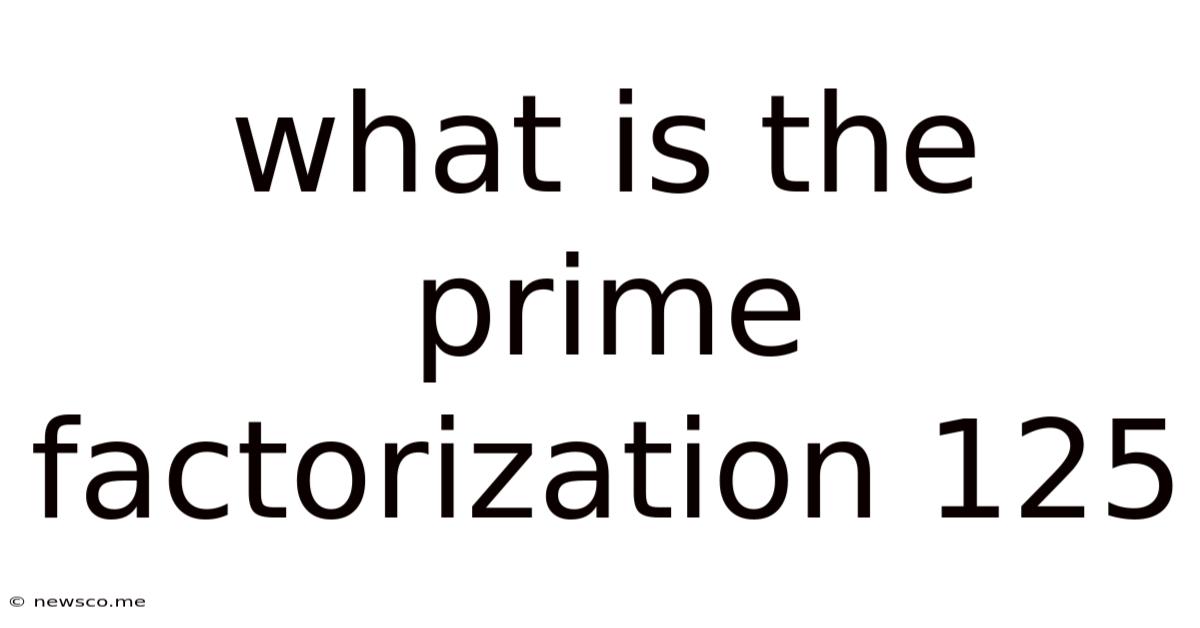What Is The Prime Factorization 125
News Co
May 08, 2025 · 4 min read

Table of Contents
What is the Prime Factorization of 125? A Deep Dive into Prime Numbers and Factorization
Prime factorization is a fundamental concept in number theory with far-reaching applications in mathematics, computer science, and cryptography. Understanding prime factorization is crucial for various mathematical operations and problem-solving. This article will explore the prime factorization of 125, providing a comprehensive explanation of the process and its significance. We'll also delve into the broader concepts of prime numbers and factorization, enhancing your understanding of this core mathematical principle.
Understanding Prime Numbers
Before we tackle the prime factorization of 125, let's clarify what a prime number is. A prime number is a natural number greater than 1 that is not a product of two smaller natural numbers. In simpler terms, a prime number is only divisible by 1 and itself. The first few prime numbers are 2, 3, 5, 7, 11, 13, and so on. Note that 1 is not considered a prime number.
The significance of prime numbers stems from the Fundamental Theorem of Arithmetic, which states that every integer greater than 1 can be uniquely represented as a product of prime numbers, disregarding the order of the factors. This unique representation is known as the prime factorization of the number.
Finding the Prime Factorization of 125
Now, let's determine the prime factorization of 125. We can use a method called the factor tree to visualize the process.
The Factor Tree Method
-
Start with the number 125. Since 125 ends in 5, we know it's divisible by 5.
-
Divide 125 by 5: 125 / 5 = 25. So, we have 125 = 5 x 25.
-
Continue factoring: Now, we need to factor 25. 25 is also divisible by 5.
-
Further division: 25 / 5 = 5. So, we have 25 = 5 x 5.
-
Reach prime factors: We've now reached a point where all the factors are prime numbers (5).
Therefore, the prime factorization of 125 is 5 x 5 x 5, or 5³.
Alternative Method: Repeated Division
Another method to find the prime factorization involves repeatedly dividing the number by its smallest prime factor until you reach 1.
-
Start with 125. The smallest prime factor of 125 is 5.
-
Divide 125 by 5: 125 / 5 = 25.
-
Divide 25 by 5: 25 / 5 = 5.
-
Divide 5 by 5: 5 / 5 = 1.
Since we've reached 1, the prime factorization is the product of all the divisors we used: 5 x 5 x 5 = 5³.
Why is Prime Factorization Important?
The seemingly simple process of prime factorization has significant implications across various fields:
1. Number Theory
Prime factorization is fundamental to understanding the properties of integers. It forms the basis for many advanced theorems and concepts in number theory, including:
-
Greatest Common Divisor (GCD): Finding the GCD of two numbers involves finding their prime factorizations and identifying the common prime factors raised to the lowest power.
-
Least Common Multiple (LCM): The LCM is calculated similarly, using the prime factorizations to identify all prime factors raised to the highest power.
-
Modular Arithmetic: Prime numbers play a crucial role in modular arithmetic, which is widely used in cryptography.
2. Cryptography
Prime factorization is at the heart of many modern cryptographic systems. The difficulty of factoring very large numbers into their prime components is the foundation of algorithms like RSA, which is used to secure online communications and transactions. The security of these systems relies on the computational infeasibility of factoring extremely large numbers.
3. Computer Science
Prime factorization algorithms are used in various computer science applications, including:
-
Hashing: Prime numbers are often used in hash table algorithms to minimize collisions and improve efficiency.
-
Random Number Generation: Prime numbers are essential in creating pseudo-random number generators, which are crucial for simulations and other computational tasks.
-
Data Compression: Some data compression algorithms utilize prime factorization to efficiently represent data.
Exploring Further: Properties of 125 and its Prime Factorization
The fact that the prime factorization of 125 is 5³ highlights some interesting properties:
-
Perfect Cube: 125 is a perfect cube, meaning it's the cube of an integer (5³ = 125).
-
Power of 5: It's a power of 5, specifically 5 raised to the power of 3.
-
Divisibility: Understanding the prime factorization allows us to easily identify all the divisors of 125. The divisors are 1, 5, 25, and 125.
Conclusion: The Importance of Prime Factorization
The prime factorization of 125, 5³, is more than just a simple mathematical result. It's an illustration of a fundamental concept with profound implications in various fields. From its role in number theory to its crucial contribution to modern cryptography and computer science, understanding prime factorization is essential for anyone interested in mathematics and its applications in the real world. The seemingly simple act of breaking down a number into its prime constituents unlocks a world of mathematical possibilities and empowers us to understand and manipulate numbers in powerful and significant ways. Mastering this concept is a key step in developing a strong foundation in mathematics and its applications.
Latest Posts
Latest Posts
-
What Is The Length Of Side Ab Of Parallelogram Abcd
May 08, 2025
-
4 1 3 As A Decimal
May 08, 2025
-
Can A Kite Be A Trapezoid
May 08, 2025
-
Does A Rhombus Have 4 Right Angles
May 08, 2025
-
Is 21 A Even Or Odd Number
May 08, 2025
Related Post
Thank you for visiting our website which covers about What Is The Prime Factorization 125 . We hope the information provided has been useful to you. Feel free to contact us if you have any questions or need further assistance. See you next time and don't miss to bookmark.